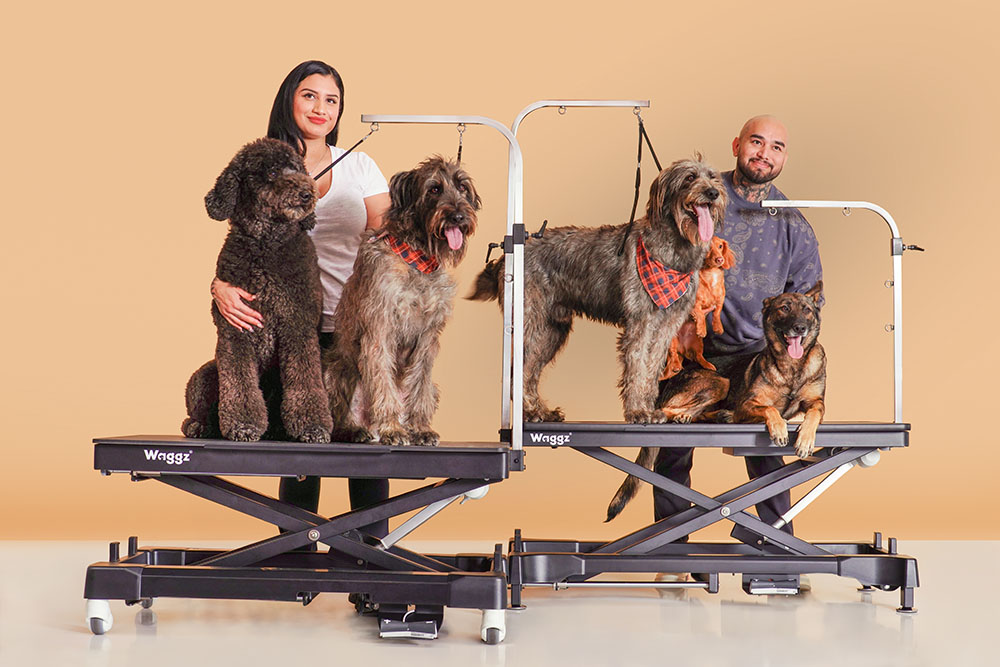How Often Should You Groom Your Dog

“How often should I take my dog to the groomers?” That’s one of the most common questions that pet parents search for, and it’s easy to understand why: it depends. The American Kennel Club recommends that most breeds be groomed once a month and receive at-home care, like teeth and hair brushing, in between appointments.
However, the classic ‘once a month’ recommendation isn’t a universal solution. Short-haired Dobermans need to be groomed far less often than a double-coated shiba inu! Above all, it’s important to follow your local dog groomer’s advice and adjust to your dog’s unique needs.
Factors That Influence Grooming Frequency
Dog’s Breed
Every breed has unique grooming needs, which can drastically affect how often you should groom your dog. For example, breeds with long, luxurious coats like the Afghan Hound or Shih Tzu require frequent grooming to prevent mats and tangles. On the other hand, short-haired breeds such as Beagles or Boxers need less frequent grooming as they shed more uniformly and don’t mat as easily.
Certain breeds like Poodles, Bichon Frises, and Schnauzers require more regular grooming due to their curly or non-shedding coats, which can easily become tangled or dirty.
Coat Type and Length
Your dog’s coat type and length are significant factors in determining grooming frequency.
- Short-Coated Dogs: Breeds like Beagles, Chihuahuas, and Doberman Pinschers typically shed regularly, which means they require less brushing. However, you’ll still need to brush them weekly to remove loose fur and reduce shedding around the house.
- Long-Coated Dogs: Dogs like Collies, Golden Retrievers, and Shetland Sheepdogs have long coats that can become tangled and matted. These breeds require grooming several times a week to keep their coats healthy and free of mats.
- Curly and Poodle-like Dogs: Dogs with curly coats, such as Poodles and Portuguese Water Dogs, need regular grooming—often every 4 to 6 weeks—to maintain their coats and prevent matting. Regular brushing is essential to prevent tangles and maintain a neat appearance.
Age and Health of Your Dog
The age and health of your dog can also influence grooming frequency. Puppies, for instance, may need less grooming, but they still require routine brushing to get them used to the process. As dogs age, they may need more frequent grooming to manage issues such as dry skin, matting, or shedding. Dogs with health conditions—such as skin allergies, arthritis, or obesity—might require more frequent grooming to maintain hygiene and comfort.
How Often to Groom Different Dog Types
Short-Haired Dogs
Your pup fits the short-haired category if their coat is straight and less than one inch long, like Labrador retrievers, bull terriers, pugs, greyhounds, chihuahuas, dalmatians, and rottweilers. The groomer (likely) won’t ever need to give them a haircut, and drying them off with a force dryer only takes a second.
Yes – their fur is short, but brushing is still an important weekly task, especially before baths. Give them a feel-good massage with a flexible wire brush or silicone glove to remove loose hair and invigorate their skin.
Short-haired dog breeds can usually go up to six weeks between appointments, but many owners prefer weekly baths at home to keep highly active dogs clean. Just keep in mind that bathing too often might dry out sensitive skin and cause irritation. Moisture-rich dog shampoos and conditioners are a great way to repair and protect natural oils.
Long-Haired Dogs
If you own a long-haired dog, you need to invest in a high-quality grooming comb! Daily brushing and combing through their fur is the best way to prevent knots, tangles, and matting. Maintaining long hair takes a little more work, but it’s a great way to bond with your pup and show them a little extra love every day.
Time between grooming haircuts can vary widely, even within the long-haired category. If you want the hair to grow out and stay long, make sure that it’s never covering their eyes or collecting dirt and debris near the ground. Most groomers recommend alternating appointments by scheduling a bath every 4-6 weeks and a full groom haircut every 8-12 weeks.
Groom Curly Dogs
Watch out for matting, tangles, and lingering dirt! Poodles, bichon frises, and other curly-haired breeds typically shed less than most, but they also require consistent upkeep. Use a slicker brush to gently work through wavy fur and brush away from the skin. Groomers recommend brushing at least three times a week to keep the coat in great condition between appointments.
Most curly-haired dogs need a full grooming appointment, including a bath and haircut, every 3-4 weeks.
Wire-Coated Dogs
Wire-coated dogs typically don’t shed, but regular brushing during the week can remove loose hair and prevent uncomfortable matting. Their wiry, bristly hair may require a light trim on the face and paws every 4-6 weeks if it grows out.
Silky Dogs
‘Silky’ breeds, like the afghan hound and irish setter, tend to have oilier skin than most. Without an undercoat to balance and absorb skin oils, you’ll probably need to take them to the groomer for a bath every 3-4 weeks.
Double-Coated Dogs
Dog breeds with double coats typically require less professional grooming help and more frequent upkeep at home. Double coats regulate temperature and protect sensitive skin, so it should never be shaved down. We recommend asking about proactive deshedding services to remove lingering dead hair, or you can blow it out at home with a dog grooming pet dryer.
Long double coats require monthly bathing because they tend to be thinner. If your dog has a short, dense double coat, it won’t need to be washed as frequently. Did you know that most huskies only go to the groomers two or three times a year?
Even if your dog’s grooming needs are simple and infrequent, remember that you can always ask a local pet groomer for help.
Signs Your Dog Needs Grooming More Often
Certain signs can indicate that your dog needs more frequent grooming:
- Excessive Shedding: If your dog’s shedding seems out of control, it may be time to brush more often.
- Tangled or Matted Coat: Long-haired or curly dogs are prone to mats, especially behind the ears and under the legs.
- Itching or Scratching: This could be a sign of dry skin, allergies, or pests. Regular grooming can help alleviate discomfort.
- Unpleasant Odor: If your dog starts smelling bad even after a recent bath, it may be time for a more thorough grooming.
DIY Grooming vs. Professional Grooming
When to Groom Your Dog at Home
Basic grooming tasks like brushing, nail trimming, and ear cleaning can usually be done at home with the right tools. Grooming at home is cost-effective and provides an opportunity for bonding with your pet.
When to Schedule a Professional Grooming Appointment
Professional grooming is ideal for tasks that require specialized skills, such as intricate cuts, heavy mat removal, or dealing with complex skin conditions. If you’re unsure about your dog’s grooming needs or face challenges maintaining their coat, booking a professional grooming appointment every few weeks might be necessary.
A local groomer can also help your dog live a long, healthy life. Get your dog checked out by a trained professional who can offer second opinions and help spot health issues. You may not notice early signs of infection during everyday walks and play, but groomers take a closer look. If they notice any lumps, bumps, or rashes, the groomer will most likely point them out to you at the end of the appointment.
Not every dog grooming appointment has to be a full-service experience, and it’s okay to ask your groomer for advice about upkeep. Above all, remember that most professional groomers make a powerful promise: this salon will never hurt a pet to please a person.
Conclusion
How often you should groom your dog depends on their breed, coat type, health, and activity level. Regular grooming not only keeps your dog looking great but also promotes their overall well-being. Be sure to incorporate brushing, nail trimming, ear cleaning, and bathing into your routine, and adjust the frequency as needed based on your dog’s individual needs. Whether you’re grooming at home or visiting a professional, a consistent grooming schedule will help your dog stay comfortable and happy.
FAQ
What about extra dog nail appointments?
How quickly do your dog’s nails grow? You might need to schedule an extra pet grooming visit to grind and shape nails back down to a healthy length. Ask your dog groomer about staggered scheduling options, so that you can pop in for a quick nail trim between full appointments. Even if it’s not time for a haircut, your groomer can help with nails.
If you hear a ‘clicking’ sound when they walk on the pavement, it’s time to clip your dog’s nails. You might also see the nails curling and extending past the level of his paw toward the floor. Don’t wait! Over time, you and your dog groomer will be able to build a healthy schedule and maintain the right length.
How often should I bathe my dog?
Most dogs need a bath every 4-6 weeks, but active dogs or those with skin conditions may need more frequent bathing. Avoid overbathing, as it can dry out their skin.
What happens if I don’t groom my dog regularly?
Neglecting grooming can lead to mats, skin infections, overgrown nails, ear infections, and general discomfort for your dog. Regular grooming promotes both hygiene and comfort.
Do short-haired dogs need grooming?
Yes, short-haired dogs still benefit from regular brushing, nail trimming, ear cleaning, and bathing to maintain their health and hygiene.








